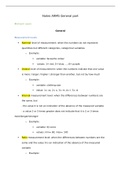Summary
Complete samenvatting ARMS/VOS
- Course
- Institution
- Book
Deze samenvatting bevat aantekeningen van colleges, Grasple lessen en werkgroepen, inclusief voorkennis informatie. De samenvatting gaat over de General part van ARMS bij Psychologie en kan ook gebruikt worden voor het vak VOS bij andere opleidingen binnen de sociale wetenschappen.
[Show more]




